Environmental Management in Oil and Gas Industry
Added on 2022-11-19
21 Pages5912 Words359 Views
ENVIRONMENTAL MANAGEMENT 1
Title
Author’s name
Institutional affiliation
Title
Author’s name
Institutional affiliation
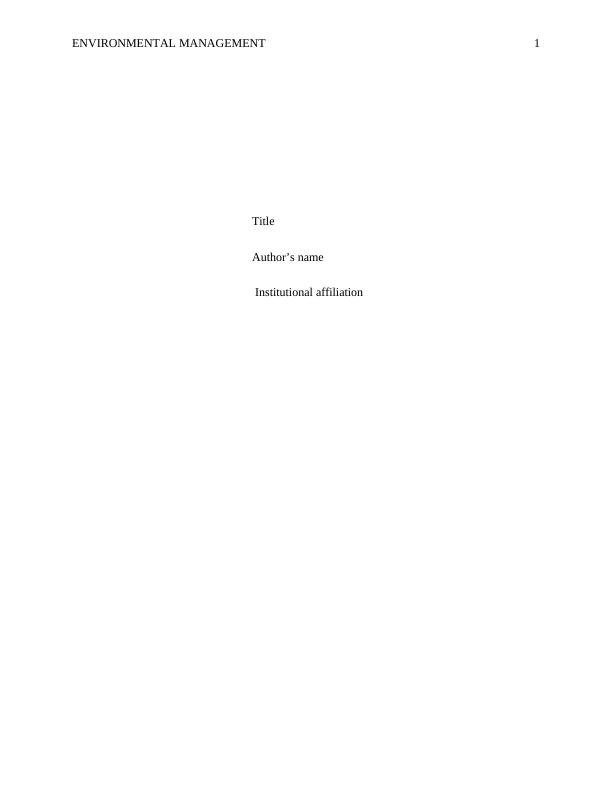
ENVIRONMENTAL MANAGEMENT 2
Table of Contents
Executive Summary................................................................................................ 3
Introduction............................................................................................................. 3
Problem Statement................................................................................................. 4
Research Questions................................................................................................ 5
Literature Review................................................................................................... 5
Results...................................................................................................................... 9
Discussions............................................................................................................ 11
Conclusion.............................................................................................................. 16
Recommendations................................................................................................ 17
References............................................................................................................. 18
Table of Contents
Executive Summary................................................................................................ 3
Introduction............................................................................................................. 3
Problem Statement................................................................................................. 4
Research Questions................................................................................................ 5
Literature Review................................................................................................... 5
Results...................................................................................................................... 9
Discussions............................................................................................................ 11
Conclusion.............................................................................................................. 16
Recommendations................................................................................................ 17
References............................................................................................................. 18
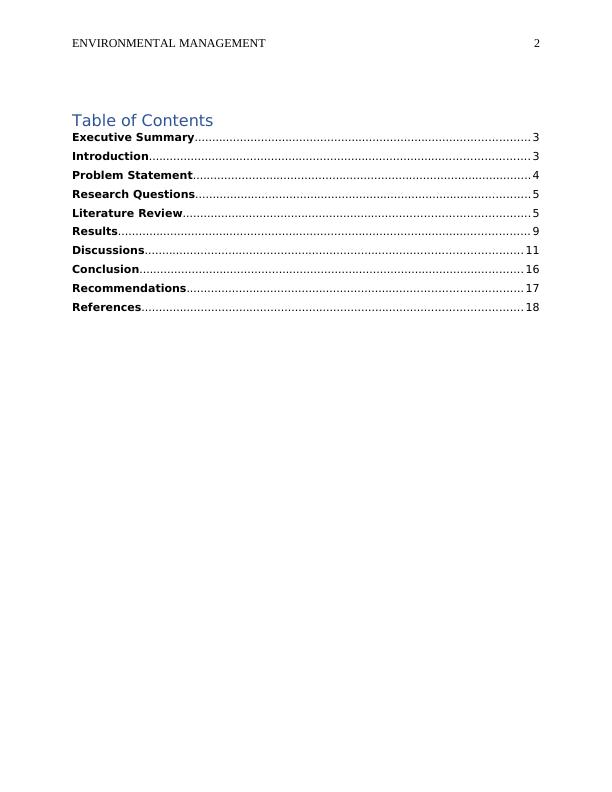
ENVIRONMENTAL MANAGEMENT 3
Executive Summary
Oil and Natural gas are the primary energy for the constantly increasing world
population. However, the use of coal and petroleum has become the major cause of pollution.
Water with high salinity levels was started being experienced at the onset of oil exploration. Oil
exploration, production and distribution are done in three major sections, the upstream, the
midstream and the downstream sections of the industry. Understanding the processes involved in
the industry leads to comprehending the potential associated adverse impacts. The stages and
processes have diverse effects. Strong commitment to environmental protection is key to
protecting the environment and ensuring that the standards of oil production are met with
minimum adverse effects on the environment. A major difference in the journey of waste
management will be brought forth by re-use, re-use, reduction, recovering, recycling treatment
and responsible disposal of the material. As the different processes are being embraced in
dealing with oil exploration management, being sure to properly examine the risk, nature, size
and consequence that may occur in the case of an oil spill will considerably ensure that
environmental conservation.
Introduction
The lifeblood of the planet earth can be equated to energy. The economy is constantly expanding
every other day, constant powering of the expansion is necessary for the wellbeing of the society.
Hence, the need for energy. Oil and Natural gas have been the primary energy for the constantly
increasing world population since the 1950s (Steven Hackett, 2014). Considerable change is not
expected any time soon, as a result, it is expected that the dominance of oil and natural gas will
be realized in several decades coming ahead. Despite enjoying the many benefits that come with
Executive Summary
Oil and Natural gas are the primary energy for the constantly increasing world
population. However, the use of coal and petroleum has become the major cause of pollution.
Water with high salinity levels was started being experienced at the onset of oil exploration. Oil
exploration, production and distribution are done in three major sections, the upstream, the
midstream and the downstream sections of the industry. Understanding the processes involved in
the industry leads to comprehending the potential associated adverse impacts. The stages and
processes have diverse effects. Strong commitment to environmental protection is key to
protecting the environment and ensuring that the standards of oil production are met with
minimum adverse effects on the environment. A major difference in the journey of waste
management will be brought forth by re-use, re-use, reduction, recovering, recycling treatment
and responsible disposal of the material. As the different processes are being embraced in
dealing with oil exploration management, being sure to properly examine the risk, nature, size
and consequence that may occur in the case of an oil spill will considerably ensure that
environmental conservation.
Introduction
The lifeblood of the planet earth can be equated to energy. The economy is constantly expanding
every other day, constant powering of the expansion is necessary for the wellbeing of the society.
Hence, the need for energy. Oil and Natural gas have been the primary energy for the constantly
increasing world population since the 1950s (Steven Hackett, 2014). Considerable change is not
expected any time soon, as a result, it is expected that the dominance of oil and natural gas will
be realized in several decades coming ahead. Despite enjoying the many benefits that come with
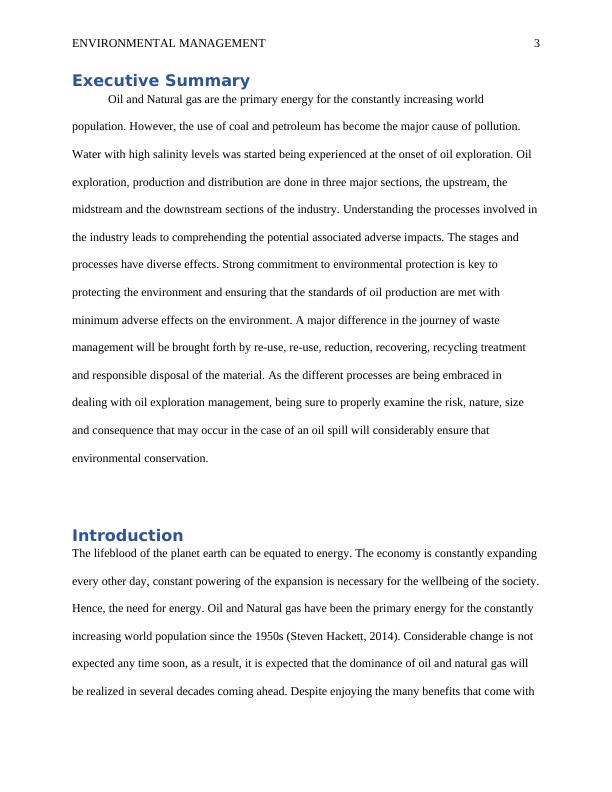
ENVIRONMENTAL MANAGEMENT 4
the consumption of oil and petroleum, there is a need to note that there are several negative
environmental impacts that come along such benefits (Georgios M. Kopanos, 2016). The impacts
may be experienced regionally or on a global scale. They are primarily seen through air
pollution, oil spills and the global change in the climate conditions all over the world. There has
been the introduction of environmental Geosciences however, it is evident that these sciences
trying to address the impacts are not in a position to address the major impacts directly. The use
of petroleum and coal are the major causes of air pollution (Steven Hackett, 2014). On the other
hand, oil spills come as a result of the ferrying if oil from one region to another. There have been
major impacts seen on the soils, surfaces and groundwater. The disposal of some large volumes
of oil not appropriately done result in such kind of impacts on the environment. Related activities
to oil exploration, distribution and refining can also result in ground disturbances. Such is seen
greatly through activities such as site clearances. Construction activities done on the roads may
also have an impact on the environment. Other land modification activities include the
construction of tank batteries, digging of brine pits and pipeline construction (Steven Hackett,
2014).
Problem Statement
Oil exploration resulted in the production of water characterized by high levels of salinity
(Whitacre, 2018). This was a significant detrimental activity that forced for the institution of
federal regulations to help in governing the disposal being done by the industries. The water is
known to have inorganic components, toxic metals, organic components, radioactive materials
resulted in salt scars, pollution on the ground and surfaces of streams, unlined evaporations
ponds and creeks. Such releases are major concerns to the petroleum producers, the owners of
the land, and regulators of the states and federations. New environmental laws have to be
the consumption of oil and petroleum, there is a need to note that there are several negative
environmental impacts that come along such benefits (Georgios M. Kopanos, 2016). The impacts
may be experienced regionally or on a global scale. They are primarily seen through air
pollution, oil spills and the global change in the climate conditions all over the world. There has
been the introduction of environmental Geosciences however, it is evident that these sciences
trying to address the impacts are not in a position to address the major impacts directly. The use
of petroleum and coal are the major causes of air pollution (Steven Hackett, 2014). On the other
hand, oil spills come as a result of the ferrying if oil from one region to another. There have been
major impacts seen on the soils, surfaces and groundwater. The disposal of some large volumes
of oil not appropriately done result in such kind of impacts on the environment. Related activities
to oil exploration, distribution and refining can also result in ground disturbances. Such is seen
greatly through activities such as site clearances. Construction activities done on the roads may
also have an impact on the environment. Other land modification activities include the
construction of tank batteries, digging of brine pits and pipeline construction (Steven Hackett,
2014).
Problem Statement
Oil exploration resulted in the production of water characterized by high levels of salinity
(Whitacre, 2018). This was a significant detrimental activity that forced for the institution of
federal regulations to help in governing the disposal being done by the industries. The water is
known to have inorganic components, toxic metals, organic components, radioactive materials
resulted in salt scars, pollution on the ground and surfaces of streams, unlined evaporations
ponds and creeks. Such releases are major concerns to the petroleum producers, the owners of
the land, and regulators of the states and federations. New environmental laws have to be
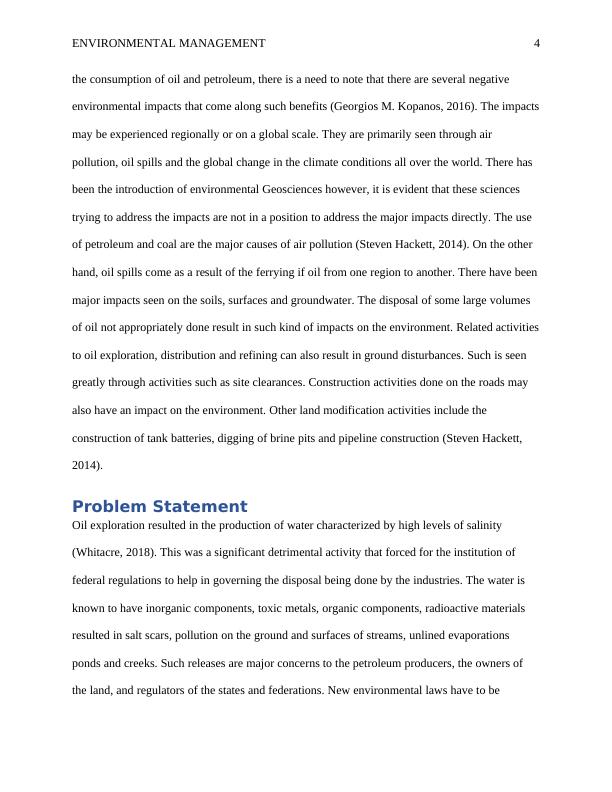
ENVIRONMENTAL MANAGEMENT 5
introduced in the society for the proper regulation of such practices (Steven A. Peterson, 2017).
Constant watch of the industry practices has to be ensured to see to it that there is an
improvement in the activities being embraced in the industries. Technology is also on the rise; it
has to be properly implemented as a way of ensuring that the most detrimental effects of
petroleum are properly eliminated.
Research Questions
What are the potential environmental impacts seeing in the environment as a result of
petroleum production, exploration, distribution and marketing?
What management measures have been instituted in the oil and gas industry to experience
a healthy exploration of the same?
What environmental protection measures can be recommended for better governing of
the operation practices?
What are the technology considerations for better management of the oil industry
avoiding environmental detrimental impacts?
Literature Review
While visiting the oil and gas industry, one will notice three major sections, the upstream, the
midstream and the downstream sections of the industry (Jacoby, 2012). Exploration and
production are majorly done in the upstream section of the industry. The oil is thereafter,
distributed in the midstream section. It is finally refined, processed and distributed to various
destinations in the downstream section. A company has a choice of being fully regarded and
perform the various processes or rather concentrate on one section of the oil industry. The area of
service also varies greatly. Certain companies operate globally and are generally referred to as
multinationals (Darrel Moellendorf, 2015). On the other hands, there are companies that have
introduced in the society for the proper regulation of such practices (Steven A. Peterson, 2017).
Constant watch of the industry practices has to be ensured to see to it that there is an
improvement in the activities being embraced in the industries. Technology is also on the rise; it
has to be properly implemented as a way of ensuring that the most detrimental effects of
petroleum are properly eliminated.
Research Questions
What are the potential environmental impacts seeing in the environment as a result of
petroleum production, exploration, distribution and marketing?
What management measures have been instituted in the oil and gas industry to experience
a healthy exploration of the same?
What environmental protection measures can be recommended for better governing of
the operation practices?
What are the technology considerations for better management of the oil industry
avoiding environmental detrimental impacts?
Literature Review
While visiting the oil and gas industry, one will notice three major sections, the upstream, the
midstream and the downstream sections of the industry (Jacoby, 2012). Exploration and
production are majorly done in the upstream section of the industry. The oil is thereafter,
distributed in the midstream section. It is finally refined, processed and distributed to various
destinations in the downstream section. A company has a choice of being fully regarded and
perform the various processes or rather concentrate on one section of the oil industry. The area of
service also varies greatly. Certain companies operate globally and are generally referred to as
multinationals (Darrel Moellendorf, 2015). On the other hands, there are companies that have

ENVIRONMENTAL MANAGEMENT 6
narrowed down to operate within a selected area. Hence, attaining the name independents. The
service and contractor companies characterize the upstream section of service. The companies
play a major role in the provision of specialist technical services, a benefit to the industry. The
common services include the geophysical surveys, cementing, drilling and catering services at
the various nearby hotels (Darrel Moellendorf, 2015). Through the days, there has been a close
partnership established between the contractors and the oil companies. The structure and culture
done by the oil companies are now being gradually instilled in the minds of the service
providers.
Understanding the potential impacts of the oil industry comes with a better understanding of the
processes involved in the oil industry (Hilyard, 2012). The process begins with exploration
surveying. A review is done on the geological maps that help in identifying major sedimentary
basins. Through aerial photography, the faults and anticlines are well identified at the site (A.W.
Martinius, 2014). The assessment of field geology is done to identify more detailed information.
Production of the detailed information will be followed by three major survey methods. They
include gravimetric, seismic and magnetic methods. The magnetic character of the various rocks
is determined through the variations in the intensity of the different magnetic field. This is done
through magnetic methods. The surface of the earth experiences variations in the gravitational
field. The gravimetric method has to be used in the determination of the various gravitational
fields. On the land and at the sea, measurements are primarily done using the aircraft. Geologic
structures are determined using seismic methods (Hilyard, 2012). The reflective properties of
the soundwaves on the rock strata play a major role in identifying the geologic structures. The
rock strata are located beneath the terrestrial and oceanic structures. A pulse in the form of a
wave is transmitted into the earth from an energy source. The existence of any different form of
narrowed down to operate within a selected area. Hence, attaining the name independents. The
service and contractor companies characterize the upstream section of service. The companies
play a major role in the provision of specialist technical services, a benefit to the industry. The
common services include the geophysical surveys, cementing, drilling and catering services at
the various nearby hotels (Darrel Moellendorf, 2015). Through the days, there has been a close
partnership established between the contractors and the oil companies. The structure and culture
done by the oil companies are now being gradually instilled in the minds of the service
providers.
Understanding the potential impacts of the oil industry comes with a better understanding of the
processes involved in the oil industry (Hilyard, 2012). The process begins with exploration
surveying. A review is done on the geological maps that help in identifying major sedimentary
basins. Through aerial photography, the faults and anticlines are well identified at the site (A.W.
Martinius, 2014). The assessment of field geology is done to identify more detailed information.
Production of the detailed information will be followed by three major survey methods. They
include gravimetric, seismic and magnetic methods. The magnetic character of the various rocks
is determined through the variations in the intensity of the different magnetic field. This is done
through magnetic methods. The surface of the earth experiences variations in the gravitational
field. The gravimetric method has to be used in the determination of the various gravitational
fields. On the land and at the sea, measurements are primarily done using the aircraft. Geologic
structures are determined using seismic methods (Hilyard, 2012). The reflective properties of
the soundwaves on the rock strata play a major role in identifying the geologic structures. The
rock strata are located beneath the terrestrial and oceanic structures. A pulse in the form of a
wave is transmitted into the earth from an energy source. The existence of any different form of
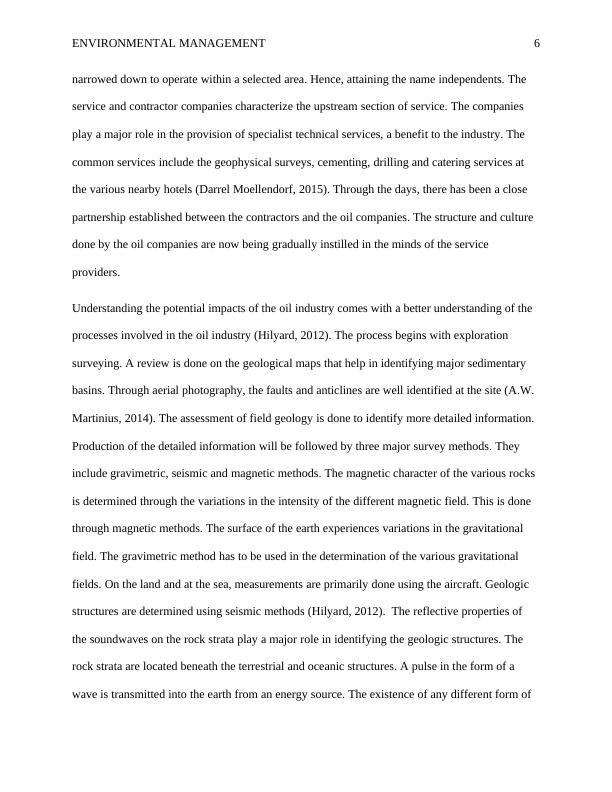
End of preview
Want to access all the pages? Upload your documents or become a member.
Related Documents
Environmental Impact of Crude Oil, Coal, and Solar Energylg...
|5
|593
|399
Air Pollution and Its Effects on the Environmentlg...
|8
|1159
|375
Waste Production In Oil Industry In Indialg...
|7
|1846
|346
Report on Oil and Gas Management and Global Warminglg...
|10
|2300
|37
Justifying the Introduction of Green Strategies and Potential of Causing Harm in Supply Chain Managementlg...
|4
|650
|393
Assignment on Environmental Sciencelg...
|7
|1625
|88
